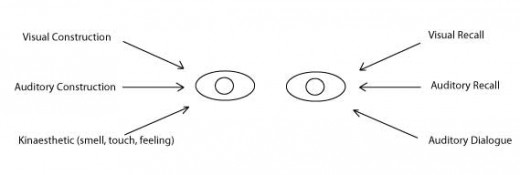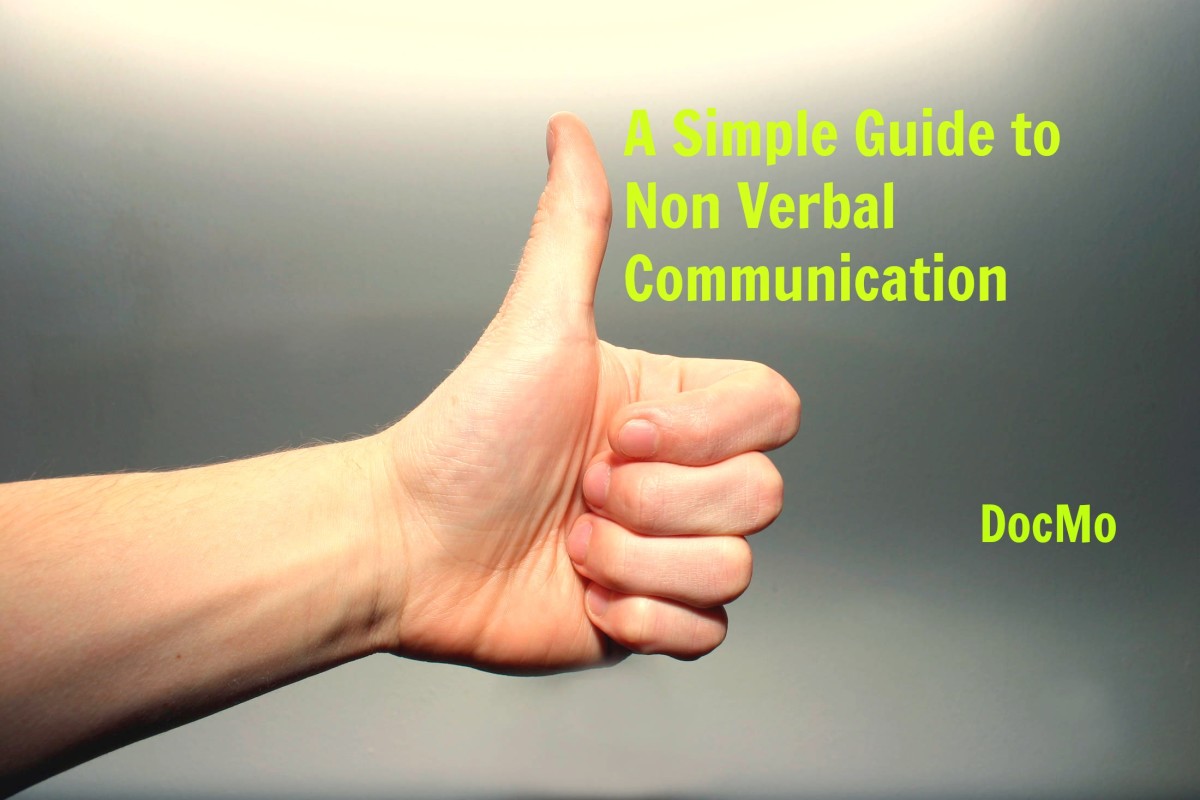Eye Accessing Cues

Influencing Others and Revealing a Lie
The concept of Eye Accessing Cues (now referred to as EAC), was developed and demonstrated in the book Frogs into Princes: Neuro Linguistic Programming (NLP), by Richard Bandler and John Grinder. What they determined was that people develop a system of responses, with their eyes, to represent whether they are thinking about visual, audio, olfactory, kinestetic, or "feeling" memories.
Utilizing their system, they suggested two possibilities:
- It was determined that an interviewer could tell, with some degree of success, whether his subject was lying.
- It was believed, and subjectively shown, that the interviewer could establish rapport with the subject and influence him positively.
For the purpose of this article, I will be detailing the concept of the EAC, how it works, and some of the fundamental methodologies related to the research. Eye Accessing Cues are a teaching of Neuro Linguistic Programming, or NLP, which will be referenced throughout the discussion.
The EAC Chart

The following chart can be used in conjunction with Eye Accessing Cues.
Specifically, note that this indicates the direction of the subject's eyes when thinking, as you are in the interview process.
How It Works.
To use the EAC system, you become an observer (hereto referred as an interviewer), and the person you are studying becomes the target (referred now as the subject).
Your objective, as interviewer, is to ask questions and observe responses. During this process, you will be seeking the base, or the template, to determine if your subject is fitting the normal EAC chart profile, or if there are any deviations. If there are any differences, you'll have to note them immediately while you are moving through the process.
Once the base has been established, you can begin to work with the subject towards greater levels of communication.
As you continue practicing, you'll be able to forego the EAC chart and it will only be a generic reference; you'll be immediately able to establish a profile of your subject's eye accessing cues and follow up with your objectives. The process can be as short as a couple minutes once you refine your technique.

The Problem With Left-handers
The reason the EAC chart becomes generic is because there is a problem with Eye Accessing Cues, and it's not a secret; a small section of the world population works in reverse. And if the person is left-handed, the chances go up to around 50%.
To curtail this problem, an experienced interviewer should ask qualifying questions; this circumvents the entire issue and gives you a template to work with in the future. As you become more affluent, you'll naturally move beyond the chart and figure out the subject's personal base within a few minutes.
Examples of "qualifyers" will be provided within their cateagories.
The Visual Cues
How People Think About Images
The typical human being is mostly visual; he likes to think in pictures. In the EAS system, the researchers found that most of us look upwards when thinking about images or things we've seen. To date, there are 3 noted types of cues:
Visual Construction (subject's upper right) - Seeing new images. When the subject looks up and to his right, he is "creating" an image. In other words, he is making it up. To determine a visual construction cue, as the subject to imagine describe something fantastic that couldn't come from memory. (Example: What would your brand new home look like?) In conversation, all you have to do is let the person talk about things he likes, and then ask him to describe something new.
Colors, are also very useful in visual construction; if your person has a black car, as him what he would think about owning a purple one. This challenges him to construct the car with a unique color.
Visual Memory (subject's upper left) - Remembering old images. When the subject looks up and to the left, he is recalling an image, one that has been seen in the past. When you are recalling, you are not making something up, and probably not lying. The qualifying question for a visual memory is easy; ask the subject to think about something favorite like a car, home, or even a friend. Ask him what it looked like.
The Blank Stare (subject stares ahead) - The person can be constructing or recalling; this is an unproductive process for the interviewer. When the subject looks directly ahead, he is typically falling into a pattern of avoidance. There is very little you can do to discern what is occurring; your best recourse is to continue the interview and attempt to relax him. As the subject relaxes, his defenses will splinter and eventually fall. Note: Some people train themselves to look ahead, or stare directly into your eyes, when they are lying. As stated: by relaxing them, their defenses will fall.
The Auditory Cues
Some people (mostly female) are highly audial; they have built many memories and thinking systems that focus on sounds. That's ok, though, because they also follow the eye accessing cues research, which is typically directly to the left or right.
Auditory Construction (subject's direct right) - Hearing new sounds. The subject is in the process of creating a new sound; he is making it up. This can also represent a lie when you are asking someone what was said in a conversation. A good set of qualifying questions for auditory construction would be to speak a word backwards (Example: How do you pronouce "national" backwards?). You could also introduce a question such as "What do you think an ionic motor would sound like?", as long as they've never heard one.
Auditory Memory (subject's direct left) - Remembering old sounds. The subject is in the recall process, and hearing something he has previously heard. Often when asked to recall a conversation, this refers to an auditory memory cue. Examples of qualifying questions would be "How do you pronouce this word?" and "Can you repeat the national anthem?"
Auditory Dialogue (subject's lower left) - Speaking to one's self, which can also be considered a constructive, or reasoning, process. This is also known as "internal dialogue", where the person is debating with himself. If you are new to EACs, the best place to check this out is on TV, where cops interview potential crime suspects. Pay close attention to the subject as he gets quiet, looks down and tries to figure out what to say. In intense situtations, people often choose to use auditory dialogue. If you ask a person a philosophical, moral, or ethics question, you are likely to receive this response. Note: This isn't directly a cue for lie, but does suggest that the person is "constructing" the truth.
The Kinaesthetic Cue
Touch, Smell, and Feeling
There is only one cue which represents the kinaesthetic level; unfortunately, it seems to show both recall and construction. It is down and to the right, and covers smell, touch, and feelings. In typical interviews, you'll want to determine this cue first, to rule it out. By asking a person how they feel today, you've qualified them. You could also ask them to describe a smell; whatever works best in your interview process.
If you see a person using the kinaesthetic cue most often, note this; they are actually very "touchy-feely". Often, they will discuss things in terms of their emotions. They may also be "hands-on", in the sense that they work often with their hands, and discuss things on that level.
How To Tell A Lie
One of the most sought after uses of EACs is to absolutely determine whether a person is lying or telling the truth. The answer, unfortunately, is that there is no "sure-fire" way; experience and practice is the only true mastery, and even then, an accomplished liar could potentially come along and fib his way through your technique.
Therefore, the first thing to understand if you're using EACs for this purpose is to keep the interview and the processt a secret. If your target understands that you're reading his eye cues, he'll become erratic in response, possibly close his eyes, or maybe just walk away. In psychology, this is a similar problem, wherein the results are represented through the responder's interpretation, or biofeedback. And so, when using this technique, it wouldn't be wise to gloat, or to ever explain how you're doing it. Unless, of course, you have no intention of using it later.
Construction is the Key
To determine a lie, look for the "Construction" cues, which are typically to the right. If he starts looking to your left (their right), that means he is making up his answer. To affirm the responses, it's best to ask them the same question in different ways.
Internal Dialogue is Tricky
If you are in the process of determining the truth, especially when interviewing a child or subordinate, be ready for the auditory dialogue cue. Often, he will look down and to (his) left while reasoning out how to tell you "his" version of the story. You'll find that recognizing this cue is pretty easy, because they'll use it for many seconds at a time.
But in that regard, don't automatifcally assume the auditory dialogue cue is lying. A subject can be working out a sequence of events, trying to make sense out of things, as well. As you increase your skill, you'll be more gifted at telling which is which.
Communication and Rapport - Techniques to Influence Others
The process of establishing rapport is based on your ability to understand the subject. If you know how he or she is reacting, then you are capable of responding in the most (or least, if that is your wish) manner. And note, that this means "knowing" what a person is doing through the EAC system is not enough; sympathetic or antipathetic response is just as important.
So, if you detect that the subject spends most of his time in visual recall, you'll find that speaking to him in terms of sight and "seeing", using imagery works best. Were you to speak about "hearing" and sounds, your ability to establish rapport would find resistance and be stifled.
Matching
The key principle in establishing rapport is a process known as matching, sometimes called "reflecting". In this broad technique, you allow the subject to converse and relax, noting body language, conversation, and cues.
With body language, you lean forward if they lean forward; when they cross their arms or legs, you eventually do the same. What you are showing them, when you match them, is that you are like them and you agree with them on a subconscious level.
In conversation. the key is to focus on their topics, repeating some of their most intense phrases. For example, if he talks about the difficult day at work, you might respond, "I am really sorry about your difficult day at work" or better "You really had a hard day today, I bet." As long as you are focusing on their descriptions, you'll be sympathizing with their feelings.
Concerning cues, or more specifically, eye accessing cues, you have the ability to match the subject at an even greater level. In the course of conversation, even when they are not talking, you'll be using them to determine if the subject is following a visual, audial, or feeling path of thought. For example, if the subject says "I had a hard day at work today" and looks up and to the left, you can respond with "You had a difficult day? What did you see happen?" In your response, you've matched their conversation and noted their visual memory cue. Then you asked them to follow through be asking them to "see", and recall, what happened.
In establishing rapport, you'll be doing this repeatedly. Wait for the cue, then match it by talking through the same language system. If they are talking visual, respond with visual. Talking feeling, respond with feeling. Practice is the key; you'll begin to note a change in your relationships, including the spontaneous ones.
A note on antipathetic communication: An easy way to make someone disagreeable to you is to simple use the cues in reverse. If they are talking in visual, you can switch to another mode. It works on an unconscious level, so it's more of a passive aggressive technique.
Thanks for your time. I'm looking forward to any comments or insight you have and would like to hear from you in the future. If you feel there's incorrect information, please let me know!







